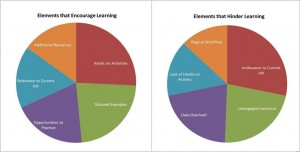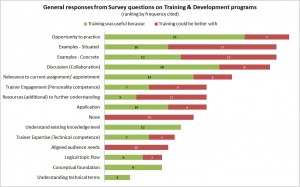What if Every Encounter Is a Learning Experience?
“Some of the best lessons we ever learn we learn from our mistakes and failures. The error of the past is the wisdom of the future.”
Tryon Edwards (1809-1894) American theologian, best known for compiling A Dictionary of Thoughts.

Image by Edwin Lee
In part one of our series, we unravel the secret sauce of a learning organization. Research suggests the average employee garners 70% of his expertise from tough workplace assignments, 20% from her peers and boss, and only 10% from training courses. Surprised? Couple this with an organization’s on-going need to make learning happen faster, and the dire question becomes “How can you create better, sustainable and more effective learning opportunities in the workplace?”
A good starting point is to be aware of the elements that do and do not promote learning.
In one U.S. firm, 100 novice engineers told us the most important elements of learning include:
- experiences directly involving day-to-day projects,
- opportunities to apply new knowledge (hands on experience)
- practice opportunities that provide a way to fail in safely while learning.
In another survey, 102 global respondents from various industries rated the relevancy of their training for usefulness, and what could better support their learning. The results corroborated with findings from the engineering firm research.
So regardless of industry, most learners are looking for specific elements to aid their learning and professional development. Corporations ignoring such elements in their learning environment are like “frogs in a pot – gradually cooked alive.”
What About Traditional, Classroom Training?
Classroom training may be part of the tools but certainly NOT the whole of knowledge building. Training is designed as a singular event to introduce new information and methods as part of workplace learning. Yet by training whole segments of an organization, the contents risk becoming oversimplified or too complex for some audiences. When participants feedback that content is irrelevant or not applicable, organizers likely have gotten their audience, timing or level of complexity wrong, thereby wasting time and resources. The act of increasing formalized training, adding trainer manpower, or upgrading delivery methods has repeatedly proven to neither impact sustainable improvements nor facilitate continuous learning.
By contrast, continuous learning is a disciplined cyclical process for knowledge building, aimed at acquiring/deepening know-how to overcome work challenges. Retained knowledge and insights can then support better decisions. Knowledge building should address a specific problem the learner faces today. It begins with relevance.
What can Managers do to design helpful learning experiences in the workplace?
The most fertile learning ground is found in everyday, commonplace opportunities – conversation, encounter, function, effort, failure and interface. By adding structure, these experiences can spark effective continuous learning experiences. We describe five elements (pillars) of learning that any supervisor can create or blend to affect sustainable knowledge building in your team.
Elements (Pillars) of a Learning Culture
ENVIRONMENT. For employees to learn, their workplace must present a recognizable gap in their know-how and decision-making process. To create a challenge that is perceived as significant by the learner, make sure the task requires a bit of extra effort – not “too easy.” And be careful not to break the learner’s confidence as she juggles work simultaneously. Supervisors should also acknowledge that they believe the staff can achieve the desired knowledge goal.
EXPERTS AS COACHES. Experts can help the learner make better decisions. With practice, most experts are capable of actively listening, delegating and offering constructive feedback during the process. Encourage experts to share what they normally consider while making choices, the consequences of their errors, and stories of how the process succeeded, changed or failed.
KNOW-HOW NOW. Conversely, it probably has been YEARS since an expert completed that similar job as a novice, so the methods previously employed could have significantly changed over time. To fill that gap, other less-senior staff levels (intermediates) may also be engaged in the activity. Coaching by intermediates may offer a more current view of obstacles, recent tools and know-how to succeed. Such involvement offers a side benefit of instilling the value of knowledge building in them.
PACE OF FLOW. As rule of thumb, mentors should consistently impart no more than four key takeaways for the learner to assimilate and practice before advancing further. There is only so much a learner can absorb from the expert’s vast web of knowledge before additional information becomes mental-overload. Be mindful that the takeaways address what the learner needs right now, today or before the next learning session.
PRACTICE. You’ve completed training on a software you hardly use, how much do you recall three weeks later even with a manual on hand? Without daily usage, a learner gradually forgets the information acquired as it is only head-knowledge. He needs real world examples to work through and exercise muscle-memory. Build practices into stretch assignments for learners to relate the knowledge to their own work experiences.
- What if Every Encounter Is a Learning Experience? - January 6, 2015
- Bring the Classroom to the Learner - May 27, 2014
- Having a Difficult Conversation? Try being an Advocate. - February 18, 2014







